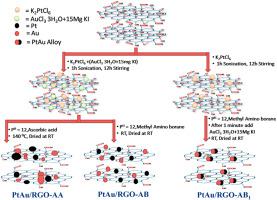Solid State Sciences ( IF 3.5 ) Pub Date : 2024-01-30 , DOI: 10.1016/j.solidstatesciences.2024.107469 G. Vishwakshan Reddy , Y. Chandra Sekhar , P. Raghavendra , M. Narendra Reddy , P. Sri Chandana , L. Subramanyam Sarma

|
Controlled construction of bimetallic interfaces on conductive carbon supports is extremely important for achieving better synergistic effect required for electrooxidation of small organic molecules for energy applications. Herein, controlled synthesis of reduced graphene oxide (RGO)-supported bimetallic Pt–Au nanoparticles (Pt–Au/RGO) for electrooxidation of methanol using a facile and practical approach was described. By carefully adapting sequential and simultaneous reduction steps H2PtCl6 and AuCl3were reduced on RGO support using ammonia borane (AB) and ascorbic acid (AA) as reducing agents. Three types of Pt–Au/RGO catalysts were prepared and labeled as PtAu/RGO-AB1, PtAu/RGO-AB, and PtAu/RGO-AA. The reduction process was carried at ambient conditions, without the use of surfactants, and the catalysts obtained were analyzed through various techniques, including X-ray diffraction (XRD), high-resolution transmission electron microscopy (HR-TEM), selected area electron diffraction (SAED), and energy dispersive X-ray spectroscopy (EDS). The PtAu/RGO-AB1 catalyst showed remarkable uniformity on the RGO sheets, with an average particle size of 2–3 nm. The electrochemical behavior of Pt–Au catalysts supported on reduced graphene oxide (RGO) for methanol oxidation was systematically investigated via cyclic voltammetry and chronoamperometry techniques. Among the studied catalysts, PtAu/RGO-AB1 exhibited high electrochemical active surface area (ECSA) of 92.47 m2/g, along with the highest mass and ECSA-normalized activities for the electrooxidation of methanol. PtAu/RGO-AB1 manifested exceptional resistance to accumulated CO-like species, as evidenced by its higher forward peak current density to reverse peak current density ratio (If/Ib) of 2.20. The facile and effective synthesis strategy described here provides a promising method for fabricating well-defined multi-component nanostructured electrocatalysts with potential applications for various fuel cell reactions.
中文翻译:

还原氧化石墨烯负载双金属 Pt-Au 纳米粒子的受控合成用于增强甲醇的电氧化
导电碳载体上双金属界面的受控结构对于实现能源应用中有机小分子电氧化所需的更好协同效应极其重要。在此,描述了使用简便实用的方法控制合成还原氧化石墨烯(RGO)负载的双金属 Pt-Au纳米颗粒(Pt-Au/RGO),用于甲醇的电氧化。通过仔细调整顺序和同时还原步骤,使用氨硼烷(AB)和抗坏血酸(AA)作为还原剂在RGO载体上还原H 2 PtCl 6和AuCl 3 。制备了三种类型的Pt-Au/RGO催化剂并标记为PtAu/RGO-AB 1 、PtAu/RGO-AB和PtAu/RGO-AA。还原过程在环境条件下进行,不使用表面活性剂,并通过各种技术对所得催化剂进行分析,包括X射线衍射(XRD)、高分辨率透射电子显微镜(HR-TEM)、选区电子衍射(SAED) 和能量色散 X 射线光谱 (EDS)。 PtAu/RGO-AB 1催化剂在 RGO 片上表现出显着的均匀性,平均粒径为 2-3 nm。通过循环伏安法和计时电流法技术系统地研究了还原氧化石墨烯(RGO)负载的 Pt-Au 催化剂用于甲醇氧化的电化学行为。在所研究的催化剂中,PtAu/RGO-AB 1表现出高达 92.47 m 2 /g的电化学活性表面积 (ECSA),以及甲醇电氧化的最高质量和 ECSA 归一化活性。 PtAu/RGO-AB 1对累积的 CO 类物质表现出优异的抵抗力,其较高的正向峰值电流密度与反向峰值电流密度之比 (I f / I b ) 为 2.20 证明了这一点。这里描述的简便有效的合成策略为制造明确的多组分纳米结构电催化剂提供了一种有前途的方法,该催化剂在各种燃料电池反应中具有潜在的应用。



























 京公网安备 11010802027423号
京公网安备 11010802027423号